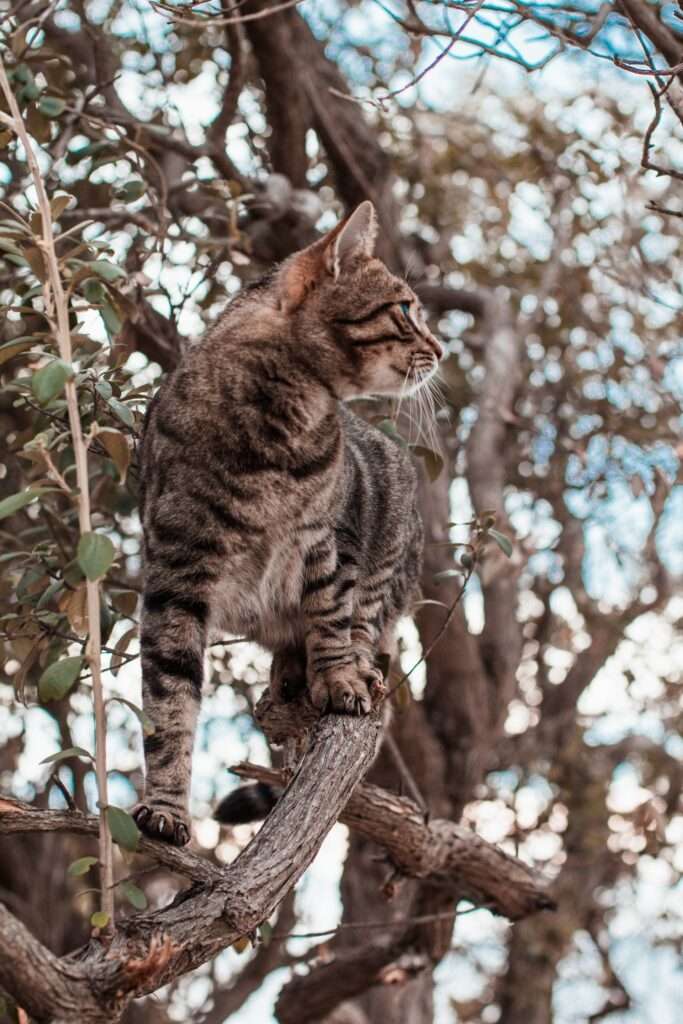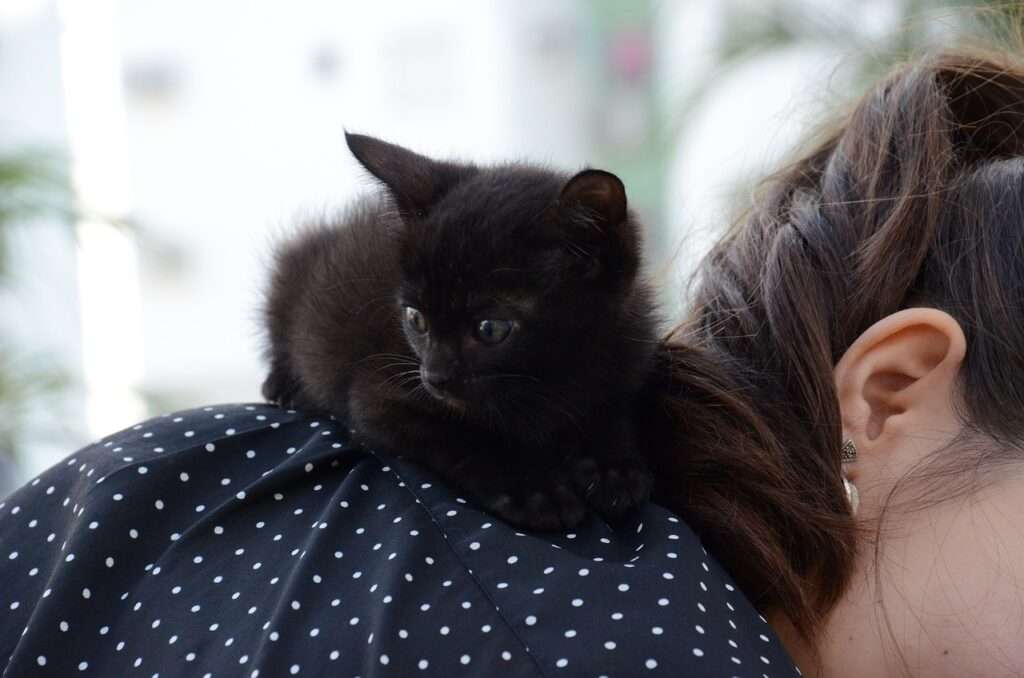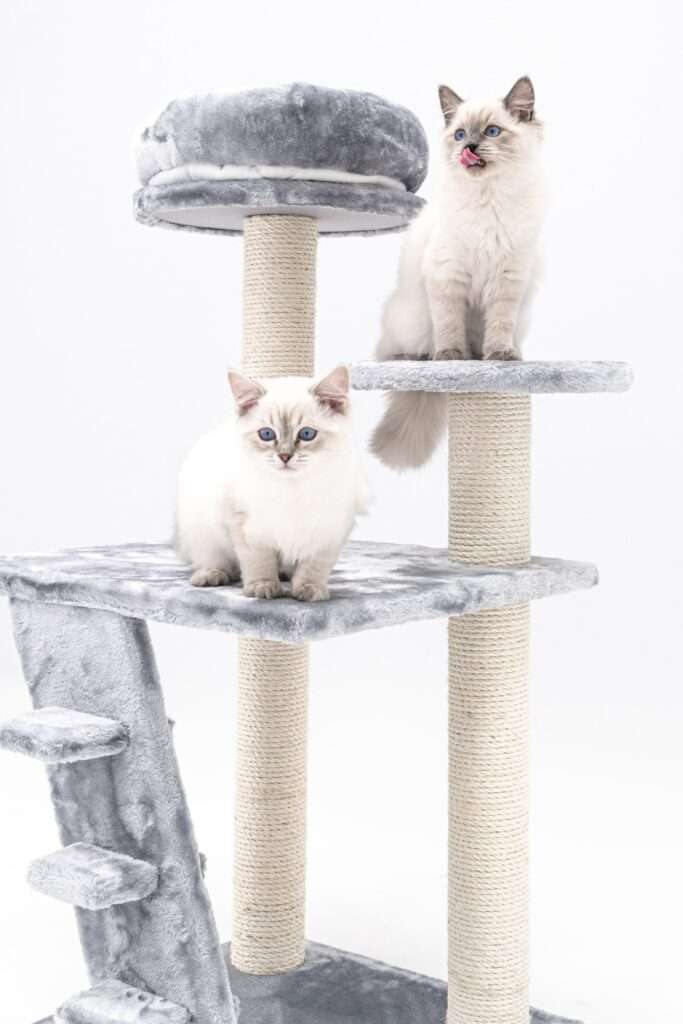Why Does My Cat Climb Me Like a Tree? Cracking the Code of Feline Climbing
Welcome, fellow cat enthusiasts, to a fascinating journey into the enigmatic world of our feline friends! Have you ever found yourself wondering why your beloved kitty transforms into a pint-sized mountaineer, ascending your limbs like a skilled climber scaling the highest peaks?
Fear not, for you’re about to embark on a thrilling expedition of discovery, as we delve into the heart of the matter: Why does my cat climb me like a tree?
A Glimpse into the Wild Ancestry

To truly grasp the perplexing habit of our domestic climbers, let us first rewind the tape of time to explore the ancient roots of our feline companions. Cats, those cunning and agile creatures, have a lineage that traces back to the untamed wilderness.
Picture the prowling wildcats navigating their natural habitats, scaling trees with a grace that captivates the imagination. This inherent talent for climbing isn’t just a nod to their adventurous spirit; it’s a whisper from the past that echoes in your living room today.
In those primordial days, climbing wasn’t merely an option; it was a necessity for survival. Cunning predators, cats utilized their remarkable climbing prowess to escape predators, chase prey, and claim their elevated territory. The trees weren’t just perches; they were platforms of safety, granting them an edge in the great tapestry of the animal kingdom.
But how does this distant past influence the quirky behaviors of our modern housecats? Stay tuned as we journey deeper into the heart of feline instinct and decipher the hidden meanings behind their tree-like pursuits. Get ready to untangle the threads of feline communication and understand why your cat seeks the heights of your affections!
The Dance of Social Connection
Imagine your home as a lush forest where your cat roams as the majestic explorer. As your feline friend scales your limbs, remember that this isn’t just a playful interaction—it’s a dance of social connection. Cats, while domesticated, retain the essence of their wild ancestors. Through climbing, they communicate a symphony of emotions that might be baffling at first glance.
Each ascent is a brushstroke on the canvas of their feelings. A climb driven by excitement, an affectionate embrace from above, or a playful leap—it’s all a part of their unique language. This communication through climbing unveils their emotions in a way that only a cat can. As you stand tall as their human perch, take pride in being privy to this silent conversation that spans generations.
A Sanctuary in the Skies

What if I told you that your lap isn’t the only cozy haven for your feline companion? Cats, masters of comfort, seek warmth not only in your cuddles but also in the heights they can attain. Picture this: your cat climbing you is more than a mere physical act; it’s the pursuit of sanctuary amidst the clouds.
In the wild, elevated perches offered cats a respite from potential threats on the ground. Fast forward to your living room, and you’ll realize that your shoulder, arms, or even your head are these modern-day sanctuaries. Cats instinctively climb you to find security, a touchstone to the instincts that have guided their species through the sands of time.
This behavior echoes the memories of their kittenhood, where the climb to their mother’s warm belly was the epitome of safety. As your cat scales you, they’re seeking that nostalgic embrace, a reassuring connection to the source of comfort. Embrace it, dear cat aficionados, for you are the living embodiment of safety and love, perched high above the mundane.
Playtime and Exercise
Ah, the joy of play—the cornerstone of every cat’s heartwarming antics! As your feline friend deftly scales you, remember that this isn’t just a display of acrobatics; it’s a testament to their insatiable curiosity and boundless energy. Cats, whether big or small, young or old, harbor an inner kitten that forever yearns to pounce, jump, and explore.
Climbing you isn’t merely a means to an end; it’s a playful rendezvous that encapsulates their zest for life. Those little paws finding purchase on your shoulder or arm are a vivid portrayal of their vibrant spirit. It’s their way of inviting you into their world of fun and frolic, where every climb is a chapter in their ever-evolving story of joy.
So, dear readers, let your hearts dance alongside those nimble paws, and embrace the playfulness that binds you and your furry companion in a bond that transcends time and space.
Attention-Seeking Behavior
Picture a feline silhouette, cast against the backdrop of your daily routine. Your cat, adorned in fur and curiosity, seeks more than just your attention—they crave your connection. As they ascend your form like a seasoned mountaineer, don’t dismiss it as mere mischievousness. Behind those sparkling eyes lies a desire to engage, to intertwine their world with yours.
Attention-seeking behavior isn’t a sign of defiance; it’s a proclamation of their affectionate intent. By scaling you like a tree, your cat isn’t just reaching new heights; they’re climbing toward a closer bond. This behavior, seemingly trivial, is a cat’s way of announcing, “I’m here, and I want to be part of your world.”
So, as your feline companion orchestrates their whimsical ascent, remember that their pursuit isn’t just upward; it’s onward, toward a deeper connection that enriches both their lives and yours.
Tips for Managing Climbing Behavior

As your feline companion continues to ascend you with grace and charm, it’s important to channel their climbing prowess in constructive ways. Fear not, for we’re here to guide you through the art of managing this unique behavior while ensuring your living space remains a harmonious haven.
- Elevated Sanctuaries: Embrace the vertical dimension by introducing cat trees, shelves, and perches. These skyward sanctuaries provide your cat with the thrill of elevation, granting them the freedom to satisfy their natural inclinations.
- Scratching Solutions: Incorporate scratching posts and boards to serve as both climbing apparatus and nail maintenance tools. By steering their energy toward these designated spots, you’ll foster a healthy and enjoyable outlet for their climbing desires.
- Interactive Playtime: Engage your cat’s insatiable curiosity with interactive play sessions. Feather wands, laser pointers, and puzzle toys keep their minds engaged and their paws occupied, reducing the urge to scale you like a mountain.
- Climbing Zones: Designate specific areas in your home where climbing is encouraged. This allows your cat to explore their inner mountaineer without interrupting your daily activities.
Understanding Your Cat’s Individuality
Step into the captivating world of feline individuality, where each cat is a unique masterpiece of personality and quirks. As your four-legged companion continues their ascent with a distinct flair, it’s essential to acknowledge that no two cats are the same. This behavior, while universal, takes on a personalized hue in the palette of your cat’s character.
The art of understanding your cat’s motivations requires keen observation and an open heart. While one might climb you for comfort, another could seek the thrill of adventure. Some may scale with grace, while others bring an endearing clumsiness to the act. By embracing their distinctiveness, you’ll forge a bond that transcends the ordinary.
Celebrate their quirks, unravel their mysteries, and revel in the tapestry of experiences you share. Our journey into the depths of feline behavior continues, unraveling more secrets that make your cat the unique marvel they are.
When to Be Concerned
As the sun sets on another day of delightful feline companionship, it’s crucial to recognize when climbing behavior takes a curious turn. While your cat’s upward escapades often signal innocent play and connection, there are instances where a closer look is warranted. By understanding when to be concerned, you’re poised to provide the best care for your beloved furball.
- Sudden Changes: If your cat’s climbing habits suddenly shift or intensify, it could indicate discomfort or underlying health issues. Pay attention to any alterations in behavior.
- Avoidance or Aggression: If your cat shies away from climbing or displays aggression during these interactions, it’s a sign that something might be amiss.
- Excessive Clinginess: While affection is wonderful, excessive clinginess, paired with incessant climbing, could signal stress or anxiety.
Remember, your vigilance as a cat parent is invaluable. If any of these warning signs manifest, don’t hesitate to consult your trusted veterinarian for guidance and support. After all, ensuring your feline friend’s well-being is the cornerstone of your shared journey.
Conclusion
As we bid adieu to this captivating exploration into the world of climbing cats, let us reflect on the fascinating journey we’ve undertaken. From ancient instincts to playful endeavors, from secure havens to tender connections, your cat’s ascent up your limbs is a testament to the multifaceted nature of feline companionship.
So, dear readers, stand tall and embrace these whimsical moments when your cat scales you like a tree. For in those fleeting instants, you’re not just a human; you’re a bridge between the wild past and the cozy present. You’re a witness to the silent conversations, the playful dances, and the unspoken yearnings that define your bond.
As you navigate the labyrinth of feline behavior, remember that you’re part of an incredible journey that transcends species. Your role isn’t just a caregiver; it’s a confidant, a companion, and a friend. With every climb, your cat whispers their trust and affection, inviting you to explore the rich tapestry of their world.
Our adventure may be drawing to a close, but the chapters of your cat’s life continue to unfold. So, embrace the quirks, cherish the climbs, and relish every moment as you walk hand in paw through this extraordinary journey of love, understanding, and companionship. Until we meet again, keep your hearts open and your spirits ready to embark on new feline escapades!
Frequently Asked Questions
Why does my cat climb me like a tree?
Cats have an innate climbing instinct rooted in their wild ancestry. They may climb you to communicate emotions, seek comfort, play, or establish social hierarchy.
Is climbing behavior a sign of affection?
Yes, climbing can indicate affection and trust. Cats often climb their owners to show love and closeness, similar to how kittens climb their mother for warmth and security.
Should I discourage my cat from climbing me?
While climbing behavior is generally harmless, it’s essential to redirect it to appropriate areas like cat trees and scratching posts. This helps maintain healthy boundaries and provides an outlet for their instincts.
What can I do to encourage positive climbing habits?
Provide vertical spaces like cat trees, shelves, and perches where your cat can climb safely. Engage in interactive play sessions using toys to redirect their climbing energy.
Could climbing indicate an underlying issue?
In some cases, sudden changes in climbing behavior or avoidance might signal health or stress-related concerns. If you notice such changes, consult your veterinarian for advice.
Can climbing behavior be attention-seeking?
Yes, cats may climb you to get attention, especially if they enjoy your reactions. Ensure you strike a balance between engaging with them and maintaining boundaries.
How do I handle excessive climbing or aggression?
Excessive climbing or aggression during climbing could be a sign of stress or discomfort. Consult your vet to rule out medical issues and consider consulting a professional behaviorist for guidance.
Are some cat breeds more prone to climbing behavior?
While climbing behavior is natural to all cats, some breeds like Bengals and Abyssinians are known for their agile and adventurous nature, which might make them more inclined to climb.
Can I teach my cat not to climb me?
Instead of stopping the behavior entirely, focus on redirecting it. Use positive reinforcement to encourage appropriate climbing spots and discourage climbing on you.
How can I better understand my cat’s unique climbing preferences?
Observe your cat’s behavior closely. Each cat has its personality and motivations. By paying attention to their cues, you can gain insights into the specific reasons behind their climbing.






